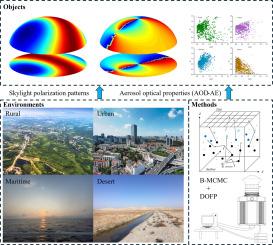不同气溶胶类型环境中天窗偏振模式的高级模拟和测量
IF 8
1区 环境科学与生态学
Q1 ENVIRONMENTAL SCIENCES
引用次数: 0
摘要
大气气溶胶显著影响天窗偏振,但由于当前模拟和测量技术的限制,人们对不同气溶胶类型环境中偏振模式的变化仍知之甚少。本研究整合了先进的模拟和测量方法,研究了农村、城市、海洋和沙漠气溶胶型环境下的天窗极化模式。利用后向马尔可夫链蒙特卡罗(B-MCMC)方法进行模拟和一种新型焦平面分割(DOFP)偏振成像系统进行实时、全天测量,研究揭示了我们研究的四种环境中偏振模式的实质性差异。农村和城市环境在较长波波段表现出较强的极化,而沙漠和海洋环境分别在UVA和长波蓝色区域表现出增强的极化。农村和海洋气溶胶的质量浓度较低,呈现出更明显的全天极化度(DOP)分布。烟尘和矿物颗粒在城市和沙漠环境中显著减弱极化,最大DOP值分别为0.524、0.464、0.576和0.442。偏振角(AOP)在各种环境中保持一致,尽管高反射率表面会引入局部偏差。不同环境也表现出不同的气溶胶光学深度(AOD)和Ångström指数(AE)特征。模拟偏振模式与实测偏振模式之间的比较显示出强烈的一致性,最大DOP差异为8.8%,这归因于复杂条件下不可探测的薄云和非球形颗粒等因素。这些结果为改进气溶胶遥感和加强对大气中极化辐射传输的认识提供了有价值的见解。本文章由计算机程序翻译,如有差异,请以英文原文为准。

Advanced simulation and measurement of skylight polarization patterns across distinct aerosol type environments
Atmospheric aerosols significantly affect skylight polarization, yet variations in polarization patterns across distinct aerosol type environments remain insufficiently understood due to limitations in current simulation and measurement techniques. This study integrates advanced simulation and measurement methods to investigate skylight polarization patterns in rural, urban, maritime, and desert aerosol type environments. Using the Backward Markov Chain Monte Carlo (B-MCMC) method for simulations and a novel Division of Focal Plane (DOFP) polarization imaging system for real-time, full-sky measurements, the study reveals substantial differences in polarization patterns across the four environments we studied. Rural and urban environments exhibit stronger polarization at longer wavelengths, while desert and maritime environments show enhanced polarization in the UVA and long-wave blue regions, respectively. Rural and maritime aerosols, with lower mass concentrations, display more pronounced full-sky degree of polarization (DOP) distributions. In contrast, soot and mineral particles in urban and desert environments significantly attenuate polarization, with maximum DOP values of 0.524, 0.464, 0.576, and 0.442, respectively. The angle of polarization (AOP) remains consistent across environments, though high-reflectance surfaces introduce local deviations. Each environment also shows distinct aerosol optical depth (AOD) and Ångström exponent (AE) characteristics. Comparisons between simulated and measured polarization patterns show strong agreement, with a maximum DOP discrepancy of 8.8 %, attributed to factors such as undetectable thin clouds and non-spherical particles in complex conditions. These results offer valuable insights for improving aerosol remote sensing and enhancing the understanding of polarized radiative transfer in the atmosphere.
求助全文
通过发布文献求助,成功后即可免费获取论文全文。
去求助
来源期刊

Science of the Total Environment
环境科学-环境科学
CiteScore
17.60
自引率
10.20%
发文量
8726
审稿时长
2.4 months
期刊介绍:
The Science of the Total Environment is an international journal dedicated to scientific research on the environment and its interaction with humanity. It covers a wide range of disciplines and seeks to publish innovative, hypothesis-driven, and impactful research that explores the entire environment, including the atmosphere, lithosphere, hydrosphere, biosphere, and anthroposphere.
The journal's updated Aims & Scope emphasizes the importance of interdisciplinary environmental research with broad impact. Priority is given to studies that advance fundamental understanding and explore the interconnectedness of multiple environmental spheres. Field studies are preferred, while laboratory experiments must demonstrate significant methodological advancements or mechanistic insights with direct relevance to the environment.
 求助内容:
求助内容: 应助结果提醒方式:
应助结果提醒方式:


